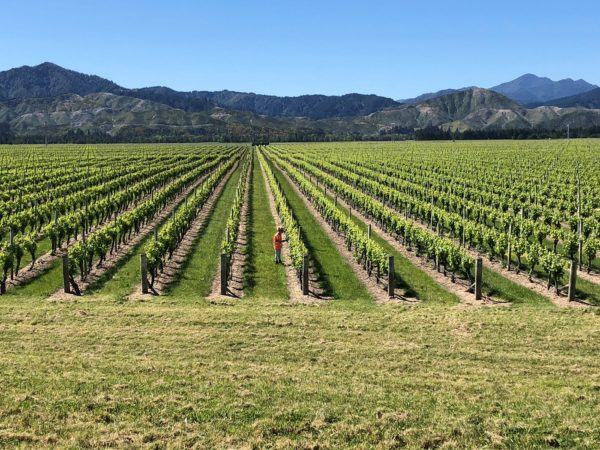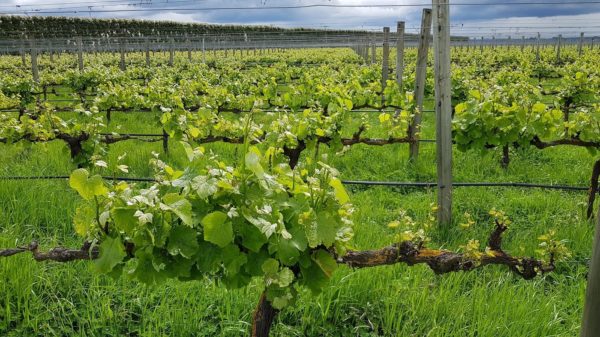Grapevine trunk disease research update
Mark Sosnowski1, Dion Mundy2 and Eline van Zijll de Jong3
1South Australian Research & Development Institute, 2The New Zealand Institute for Plant and Food Research Limited, 3Linnaeus Laboratory
Eutypa dieback (ED) and botryosphaeria dieback (BD) are grapevine trunk diseases (GTDs) that cause significant yield and quality reduction worldwide. They threaten the sustainability of New Zealand vineyards and are becoming an increasing problem as vineyards age, leading to removal of vineyards. Current research aims to optimise pruning wound protection strategies by determining the duration of susceptibility of pruning wounds, validating the curative and preventative properties of fungicides, and monitoring disease progress and spore inoculum in vineyards.
Two vineyard trials were established on 3,640 Sauvignon Blanc vines at the Marlborough Research Centre during winter 2017. In the first trial, susceptibility of wounds to dieback diseases when pruning is early (early June), mid (mid July) and late (late August) is being evaluated, as well as the duration of susceptibility following pruning. Vines were inoculated with fungal spores that cause ED and BD from 1 to 84 days after each pruning time. In the second trial, three fungicides: Gelseal Ultra™ (tebuconazole), Megastar™ (flusilazole) and Gem® (fluazinam), were applied to pruning wounds up to 7 days after pruning, and inoculated with fungal spores to evaluate curative properties. In addition, wounds were inoculated up to 14 days after fungicide application to evaluate preventative properties. Treated canes were removed in winter 2018, and assessment of the 4550 canes in the laboratory is 70% complete. Bark is being removed from each cane using a sharp knife and wood surface sterilised in bleach. Canes are cut into small chips which are placed on agar plates, followed by incubation at 22-26°C for 7 days and then assessed for presence or absence of ED or BD pathogen cultures. Assessments will be completed by the end of April 2019, and results from the first year’s trials will be reported in the end-of-year report in June 2019. Trials were repeated in winter 2018 as described above, and canes will be collected in winter 2019 for assessment.
Two Burkard spore traps are located in vineyards in Hawke’s Bay and Marlborough. The spore tape drums are changed each month and spore tape stored. The first year of spore tape samples collected daily from Hawke’s Bay and Marlborough sites have been analysed by quantitative real-time PCR (qPCR) for BD, ED and Petri disease (PD) pathogen spores, and compared against daily temperature and rainfall data from weather stations located on or in close proximity to the sites. Pathogen spores of BD and ED were detected throughout the year in both regions. The occurrence of PD pathogen spores was sporadic. In Marlborough during the first year, BD pathogen spores were frequently detected in high numbers in late spring and summer in Marlborough. These spores occurred less frequently and in lower numbers in Hawke’s Bay. The occurrence of ED pathogen spores was similar in both regions. These were more prevalent from mid to late winter through to early summer as well as in autumn in Hawke’s Bay. Rain events were regularly recorded throughout the year at both sites, and spores of BD and ED pathogens tended to be detected during and after these events. Analysis is continuing from further spore tape samples from both Marlborough and Hawke’s Bay.

Figure 1. Surveying a Marlborough vineyard in spring 2018
Grapevine trunk disease surveys were conducted in Hawke’s Bay and Marlborough in spring 2018 (Fig 1). Overall, 602 blocks were surveyed, consisting of 21 varieties, ranging from 9 to 38 years of age. In each block, 200 vines were visually assessed for dieback and foliar symptoms in a randomly selected section of each block (Fig 2). The survey comprised the same blocks that were surveyed in 2013 (NZW 13-100), revealing that 95 blocks (14%) had since been removed and 14 (2%) reworked. The overall mean incidence of dieback increased from 8 to 20%, and foliar symptoms from 0.1 to 0.3% over the 5 years across all the blocks assessed, which corresponded with an increase in average vine age from 12 to 17 years, considering only blocks from the 2013 survey were included. Overall trends in 2018 revealed variation in dieback incidence between vine ages, varieties, clones, rootstocks and pruning styles. The survey has also demonstrated short-term success of using remedial surgery for controlling grapevine trunk disease. Survey results will be detailed in a popular article later in the year.
The outcome of this research will be to develop best-practice recommendations for the critical timing of grapevine pruning and wound protection based on fungicide efficacy, wound susceptibility and spore dispersal. In future, this research will expand to other regions with different environmental conditions, and provide localised regional recommendations, which will contribute to vineyard longevity.

Figure 2. Grapevine trunk disease symptoms in a Hawke’s Bay vineyard.
This article first appeared in the April/May 2019 issue of New Zealand Winegrowers magazine

















